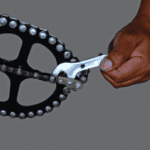As an enthusiastic cyclist, one of the key maintenance activities I regularly undertake is ensuring my chain is properly tightened. When the chain is loose, it not only becomes harder to pedal, but it can also cause harm to the bicycle’s gears and chainrings. Luckily, the process of tightening a chain is quite straightforward and can be accomplished with a handful of simple tools.
Before beginning the process of tightening the chain, it is important to assess the chain tension. This can be done by pushing down on the chain at the midpoint between the front and rear gears. A properly tensioned chain should have about half an inch of vertical play. If the chain is looser than this, it needs to be tightened.
In this article, I will walk you through the steps to tighten your chain and keep your bike running smoothly.
Key Takeaways
- Proper chain tension is crucial for a comfortable and efficient ride.
- Assessing chain tension and checking for wear before adjusting is important.
- Necessary tools for chain maintenance include a chain tool, wrench, ruler/tape measure, and lubricant.
- Lubricating the chain with the appropriate product for your riding style and environment can improve shifting performance and increase longevity.
Assess Your Chain Tension
Don’t freak out, but if your chain is sagging or making a weird noise, it’s time to check the tension. One of the most important things to know when tightening a chain is the correct chain slack measurement.
Chain slack refers to the amount of movement that the chain has, and a properly tightened chain should have about 1-2 inches of slack. To measure chain slack, locate the tightest point of the chain by rotating the pedals and shifting through all gears. Once you have found the tightest point, pull the chain up and down in the middle between the two sprockets. The distance between the bottom of the chain and the top of the chain should be about 1-2 inches. If not, your chain needs to be tightened or loosened accordingly.
If you’re troubleshooting chain tension issues, you may also want to check the chain for kinks, twists, or wear. A worn chain can cause your gears to slip, while a kinked or twisted chain can cause the bike to make a clicking noise.
Addressing these issues before tightening the chain can help ensure that your bike is running smoothly. Now that you have assessed your chain tension and checked for any issues, it’s time to gather your tools and get ready to tighten the chain.
Gather Your Tools
Before starting, make sure you’ve got all the necessary tools. This won’t take long and will save you time later. Choosing the right tools is crucial for getting the job done correctly and efficiently. To tighten your bicycle chain, you’ll need:
- A chain tool: This tool is specifically designed to remove and install bicycle chains.
- A wrench: You’ll need a wrench to loosen the bolts that hold the rear wheel in place.
- A ruler or tape measure: It’s important to have a ruler or tape measure to ensure that your chain is the correct tension.
- Lubricant: Proper lubrication will help prolong the life of your chain.
Maintaining proper chain tension is essential for bicycle maintenance. A loose chain can cause the chain to slip, making it difficult to pedal and potentially damaging the bike. Conversely, a chain that is too tight can cause excessive wear on the chain and other components, leading to costly repairs. With the right tools and a little know-how, you can easily tighten your chain and keep your bike running smoothly.
Now, let’s move on to the next step – loosening the rear wheel.
Loosen the Rear Wheel
Now it’s time to loosen up the bolts holding the rear wheel in place, so you can start adjusting the tension. This step is important to ensure that the chain is properly aligned and tensioned. Before you begin, make sure your bike is securely propped up and the chain is free from the derailleur.
To loosen the rear wheel, you’ll need a wrench or a quick-release lever if your bike has one. Loosen the bolts or open the lever on both sides of the rear wheel, but don’t remove them completely. Once the bolts are loose, push the wheel forward slightly to create some slack in the chain. This will make it easier to adjust the alignment and tension. Be careful not to pull the wheel too far out of the frame, or you may have trouble getting it back in correctly. Now you’re ready to move on to the next step and adjust the chain tension.
Adjusting the alignment of the rear wheel is crucial in making sure that the chain runs smoothly and doesn’t skip or fall off. Common mistakes when adjusting the alignment include not loosening the bolts enough, pulling the wheel too far out of the frame, or not checking the alignment with a straight edge. Once you’ve loosened the bolts and adjusted the alignment, you’ll need to adjust the tension by moving the wheel forward or backward.
Adjust the Chain Tension
You might be thinking that adjusting the tension on your bike’s rear wheel is difficult, but it’s actually easier than you may expect. First, you need to check the chain for wear and maintenance.
Chain maintenance is essential to ensure a smooth ride and prolong the lifespan of your bike’s components. You can check the chain wear by using chain wear indicators, which measure the stretch of the chain. If the chain has stretched beyond the recommended limit, it’s time to replace it.
Once you’ve checked the chain, you can adjust the tension. Start by loosening the bolts that hold the wheel in place. Then, move the wheel back or forth until the chain is at the correct tension.
The correct tension is when the chain has a slight amount of play, but is not too loose or too tight. Once you’ve adjusted the tension, tighten the bolts and recheck the tension.
With the tension adjusted, you can now reassemble the bike and take it for a test ride to ensure everything is functioning correctly.
Reassemble and Test Ride
Now that the chain tension has been adjusted, it’s time to reassemble the rear wheel and prepare for a test ride.
Firstly, reattach and tighten the rear wheel properly to ensure a safe and stable ride.
Next, lubricate the chain for smooth operation and to prevent excessive wear and tear.
Finally, test the chain tension and shifting performance to ensure that the adjustments made have been successful and the bike is ready to ride.
Reattaching the Rear Wheel
First, make sure the chain is properly threaded through the derailleur and around the cassette before reattaching the rear wheel. Proper alignment is important to ensure that the chain moves smoothly and efficiently.
Next, align the axle placement in the dropouts of the frame. Tighten the nuts or quick-release skewer evenly on both sides to ensure that the wheel is centered and secure.
Once the rear wheel is securely in place, it’s time to lubricate the chain. A well-lubricated chain is essential for smooth shifting and efficient pedaling. Applying lubricant to the chain will also help prevent rust and corrosion.
Lubricating the Chain
Properly lubricating your bike’s chain can greatly improve its performance and longevity, as the old adage goes: ‘a well-oiled machine runs smoothly.’ Not only does lubricating the chain reduce friction between the chain and the gears, but it also protects against rust and corrosion. This simple maintenance task can make a big difference in the overall quality of your ride.
When it comes to lubricating your chain, there are a variety of products available on the market. Some popular options include wax-based, dry, and wet lubricants. Wax-based lubricants are a good choice for those who ride in dry conditions, while wet lubricants are better suited for wet or rainy conditions. Dry lubricants, on the other hand, are ideal for riders who want a clean and low-maintenance option. Ultimately, the best lubrication product for your bike will depend on your riding style, environment, and personal preference.
As you can see, proper lubrication is crucial for the health and performance of your bike. Now that you know the benefits of lubricating and the best products to use, it’s time to move on to testing the chain tension and shifting performance.
Testing the Chain Tension and Shifting Performance
To ensure your ride is smooth and efficient, you’ll want to check how well your gears shift and how tight the drive train feels. Start by shifting through all of your gears and see if there’s any difficulty or delay in shifting.
If everything shifts smoothly, then it’s time to test the chain tension. To do this, you’ll need to lift the rear wheel off the ground and spin the pedals. While doing this, observe how the chain moves on the rear derailleur.
If the chain drops down or skips teeth, then it’s too loose. On the other hand, if the chain is too tight, it will make a noise and cause unnecessary wear on the chain and gears. The ideal chain tension is when the chain moves smoothly and doesn’t sag or make any noise.
Proper chain maintenance and performance optimization will ensure that your bike is always in top condition for a comfortable and efficient ride.
Frequently Asked Questions
How often should I check and tighten my bicycle chain?
Chain maintenance frequency depends on usage and weather conditions. However, inspecting for chain wear indicators regularly is crucial. A stretched chain can damage gears and sprockets. Check every 200-300 miles or weekly.
Can I use any type of lubricant on my bicycle chain?
Yes, it is important to use the correct chain lubricant types on your bicycle chain. I recommend using a dry or wet lubricant depending on the conditions you will be riding in. Apply the lubricant evenly and wipe off any excess for best lubrication techniques.
What should I do if my chain keeps slipping even after tightening it?
If my chain keeps slipping even after tightening it, I would first check for wear and damage. If these are not the issue, then I would try adjusting the derailleur or chain tension. Chain maintenance tips and troubleshooting common chain issues can help prevent this problem.
Is it necessary to have a chain tension gauge to properly adjust the chain tension?
Having a chain tension gauge isn’t necessary to adjust chain tension. Alternatives include measuring the deflection of the chain or using a ruler to measure the distance between the chain and the bike frame.
Can I ride my bicycle without properly tightening the chain?
Riding with a loose chain is like running with untied shoelaces; it’s dangerous and can cause damage to the bike. Regular chain maintenance is crucial to ensure a safe and smooth ride. Follow proper chain tensioning procedures to avoid any mishaps.
Conclusion
In conclusion, tightening the chain on a bicycle is a simple process that can be done with just a few tools. By assessing the tension of the chain, loosening the rear wheel, adjusting the tension, and reassembling the bike, you can ensure that your bicycle is running smoothly and efficiently.
Just like maintaining a bicycle, maintaining our own lives is important. We all have chains that need tightening from time to time, whether it’s in our relationships, career, or personal growth. It’s important to take the time to assess where we are and make the necessary adjustments to ensure we’re running smoothly.
By taking care of ourselves, we can enjoy the ride of life to the fullest.
















